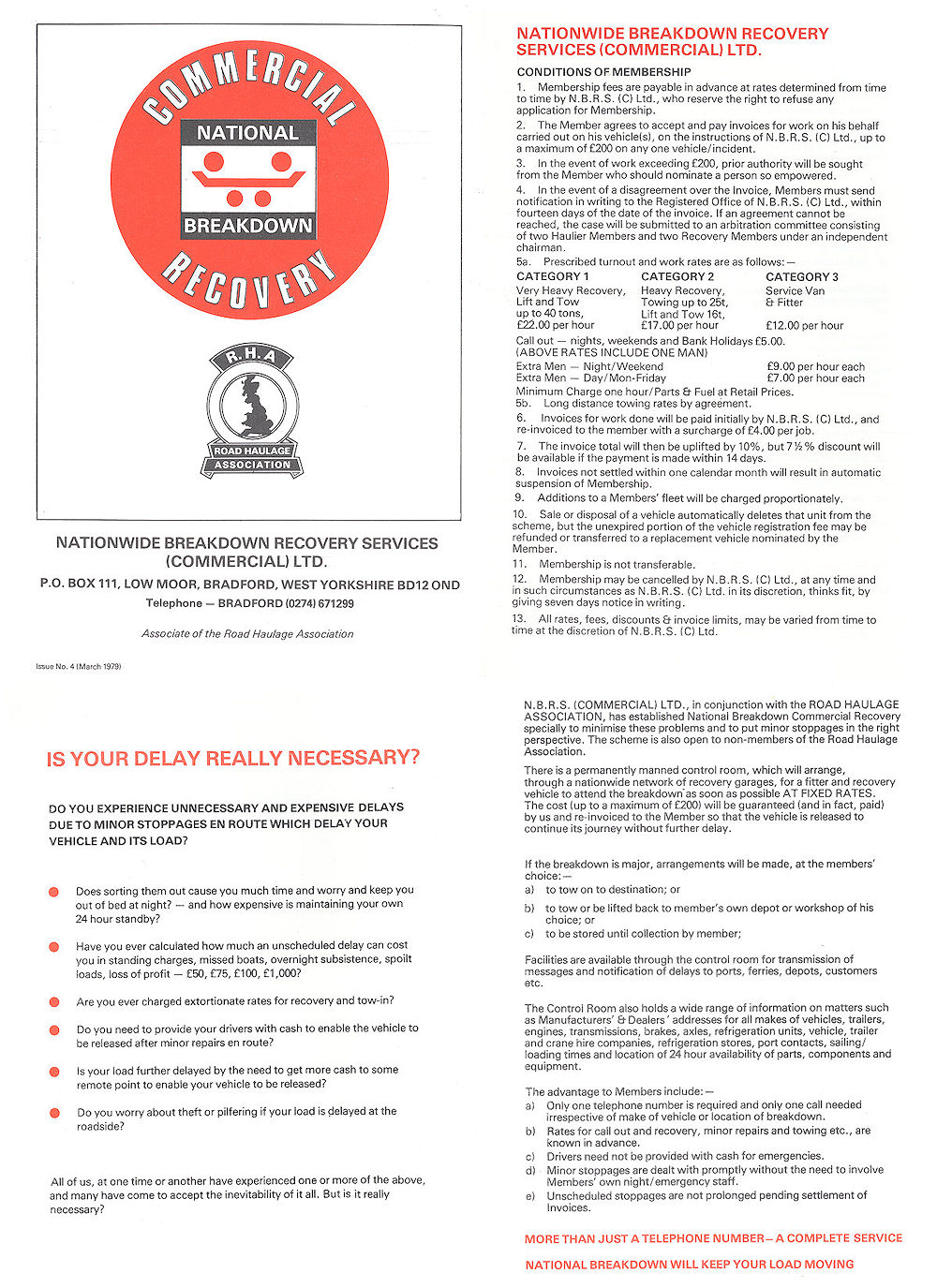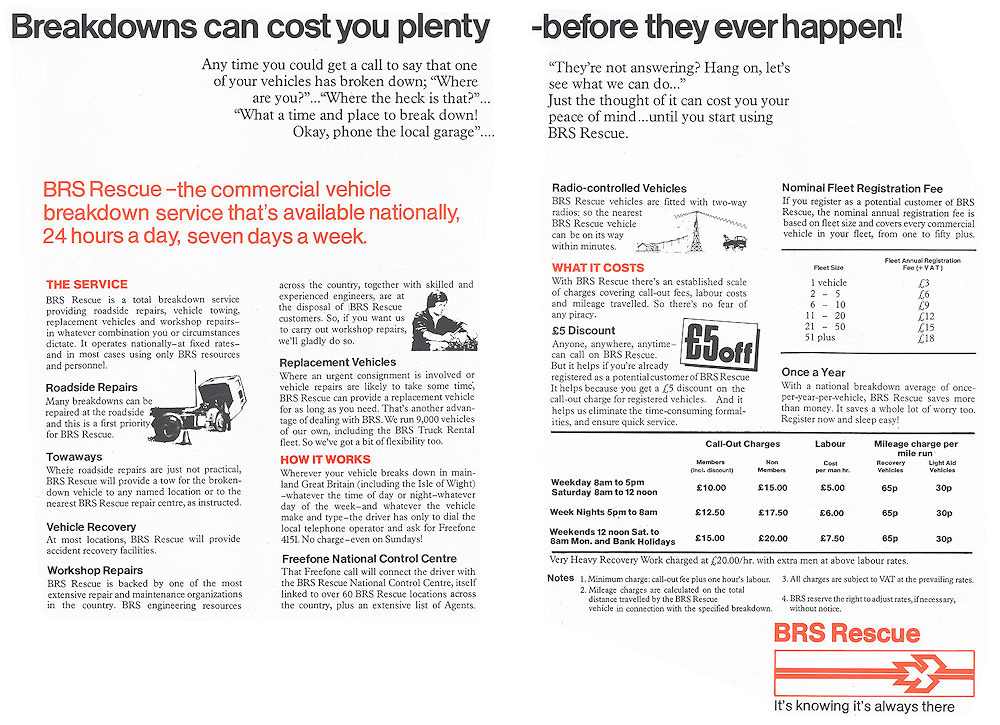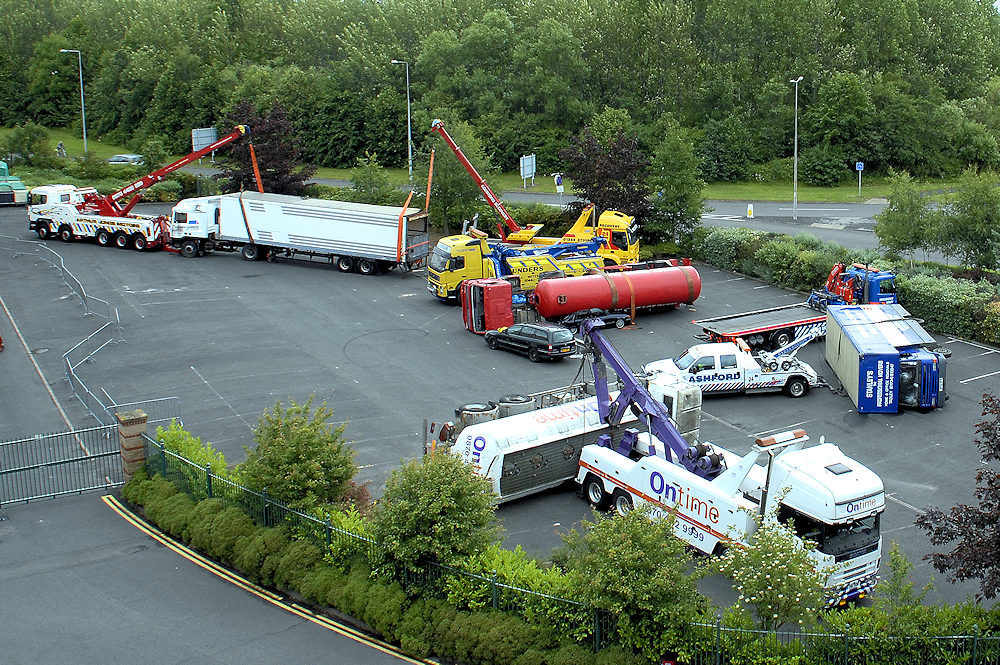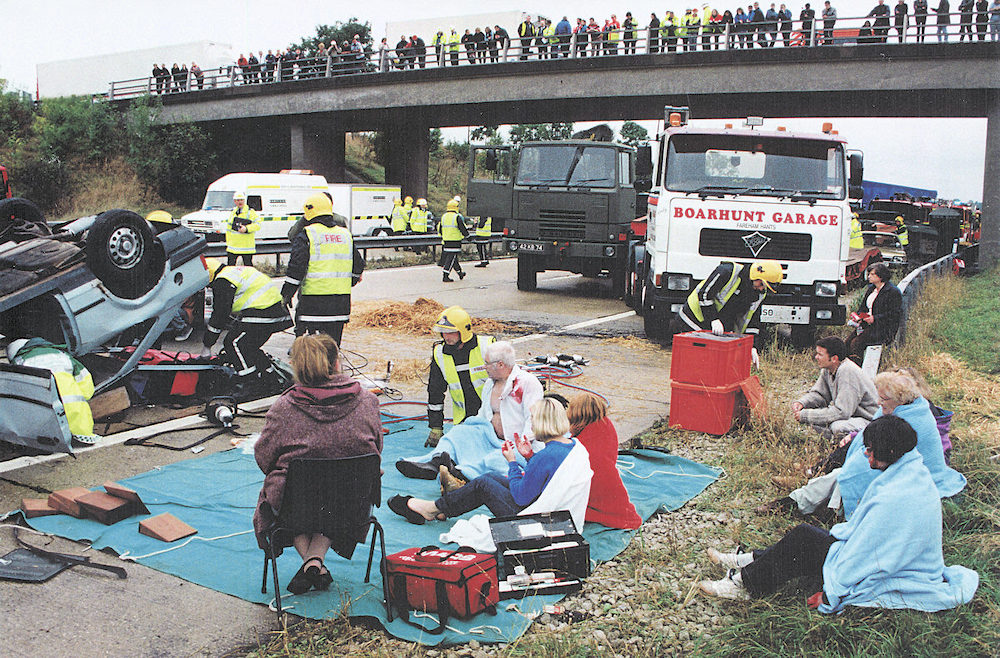Part 4 Recovery Training and Commercial Recovery
Recovery Associations
Following the growth of the car based schemes; the clubs all began to look for new areas to expand into. An obvious area to consider was the commercial vehicle market and the first to operate in it was National Breakdown Recovery Club (NBRC), when they launched a commercial scheme in 1976 under the name National Breakdown Commercial Recovery (NBCR).

The first major contract was covering vehicles manufactured by the Bedford Motor Company. To commemorate this event John Rogers owner of Unity of Leicester (who had been a key part of getting the contract) had the above painting commissioned. It shows Ernest Smith and Bob Slicer and one of Unity's fleet, outside the original National Breakdown control at Lower Moor, Bradford.
In a very short time this grew to include Fiat, Magirus Deutz, MAN and Renault, as truck manufactures tried to compete with each other. Everything was handled by NBCR and it all went through their control room. However, because of Ernest instance on giving each manufacture 'just what they wanted', the NBCR's controllers job become very difficult, making sure they followed the correct procedure for each manufacture (remember it was all paperwork then, no helpful computer console). It may surprise some operators to know that the first logo shown below was created by that great friend of the industry Brian Hagan FIVR and he say " He was very proud of his design"

BRS (British Road Services) watched the NBRC operation closely and started their commercially recovery service from around 1977. Perceiving the potential, they then preceded to took the Bedford Roadcall contract away from National Breakdown. This was achieved partly by using the large number of Bedford vehicles they operated, as a incentive to convince Bedford. Both NBRC and BRS worked on the principle of offering their member, a fixed hourly rate, unlike the existing car operations which were all mileage based. The recovery operator actually doing the work, would also get paid an hourly rate, but slightly less than the rate member was charged. Many respected operators at the time, wrote in the trade magazines about the stupidity of allowing their own customers to join a club, where the industry would still do their work, but for a significantly lower rate.
NBRC and BRS the two market leaders, were soon joined by Bob Clarke’s Octagon Recovery of Horsforth near Leeds. The company was formed in 1979, after Bob Clarke had left NBRC. There was some recrimination at the time, but just a few years later Bob sadly passed away and Ernest Smith attended the funereal and spoke kindly of him (such is the nature of the people in the industry at that time). At first Octagon operated in the same way as the others, but in in the summer of 1980 they introduced a new type of cover. Commercial Vehicle Operators were given the chance to pay a single yearly fee and receive a free breakdown and recovery service, in the same way as car drivers do. Transport Operators were deluged with smart glossy brochures (well smart for the time anyway) proclaiming why each particular organisation was the better than another.
You can compare the NBCR one with the BRS one below.


In a interesting twist BRS Rescue would eventually be purchased by the AA and merged into that organisation. Then shortly after Bob
Clarke's untimely death, Octagon became Delta Rescue and was then later purchased by the RAC.
Recovery Associations
In 1975 (and perhaps before) a number of recovery operators, talked about forming some sort of ‘Union’. or Association During 1976 National Breakdown held a meeting of their agents (attended by some 125 companies), and the topic was raised again.

The publication ‘Commercial Motor’ also got involved in the debate and at the Vehicle Recovery Conference and Exhibition held at the Esso Hotel at Wembley in May 1977 the Association of Recovery Operators (AVRO) was formed. Commercial Motor generously offered the use of Room 709, Dorset House, Stamford Street, London SE1 9LU, while the Association found its feet. The Director General was John Wells. Bob Clarke was Assistant DG. The Chairman was Terry Compton, with the AVRO Legend ‘JR’ (John Rogers) Vice Chairman. The following year AVRO News was first published, which still continues today (2010), having been through many changes. The Commercial Motor edition published on the 13th May gives full details of the event and also has a report on the conference which includes this interesting snippet "The second of the speakers to be called upon by the conference chairman John Wells was Douglas Twyford of Twyford Commercial. From the outset, Mr Twyford said: "I don't intend to teach my grandmother to suck eggs." He was sure that there were just as many qualified men, some even more so, as himself among the delegates who had plenty of experience of vehicle recovery."
He Said "One of the biggest problems, with any recovery job, comes before even turning the wheel. This is a lack of communication. All too often, when being called out by the driver, insufficient details as to location, nature of the casualty and, most importantly, type of vehicle and its load are given. This doesn't apply only to drivers, scant details are often supplied by the police force". He then cited an example where he was called out to recover a "TK Bedford" which turned out to be a 32-ton Seddon. "This wrong information can, in some circumstances, cause the driver to be in pain for longer than necessary — or even result in death — through sending the wrong size of recovery vehicle". It would be another twenty odd years before this problem would be resolved with the introduction of Turbo Dispatch.
AVRO was responsible for launching the concept of a yearly trade show, which like the magazine still survives today. In 1983 it also greatly assisted in the formation of the industry’s only institute, ‘The Institute of Vehicle Recovery (known as the IVR) The Institute is largely responsible for the very high standards practised in the in recovery industry today and anyone suffering a vehicle breakdown, owes a great debt to the many individuals who have worked so hard to make it happen. You can read more about their evolution on the 'Training' section below.
The other ‘Trade Organisation’ that can trace its roots back to the mid eighties is the RRRA (The Road Rescue Recovery Association). It was formed out of a meeting between Peter Cosby, Pete Newman and Dave Weeks (who would later form the short lived Guardian, Kent based recovery vehicle builders). RRRA was born out of a perceived desertification with AVRO and in many operators minds (and with the aid of hindsight), irrevocable weakened the industry, which never again had the 'clout' it had when it was a single trade organisation. In the nineties a 'London only' organisation was formed called LARO (London Association of Recovery Operators). The long established Road Haulage Association, also formed a ‘ Rescue and Recovery division’ in 2003 thanks largely to the tireless efforts of that great character and friend of the industry - Richard Goddard who became the first Chairmen.
The equipment manufactures formed their own association called REMSA (The Recovery Equipment Manufacturers and Suppliers Association) in 1998 (disbanded in 2017) whose job it was to set high standards for the equipment the industry uses. REMSA also dealt with arbitration between members and their customers. Under the then Chairman Chris Jones REMSA pioneered the idea of an 'All Industry' trade show, which (in 2003) Richard Goddard turned the concept into The European Tow Show. This annual event was managed by two very old hands from the industry (now both retired from the front line) Frank McAllister and Roy Jones. until sadly Roy passed away in late 2009 and then in 2010 Frank announced his retirement from show organising. It was taken over for a shortwhile by the Road Haulage Association and then by Dave Gregory of Partnership Publications who with his son Paul Gregory have held the event ever since, although Dave sadly also passed away in 2018.
No section on the 'Associations' would be complete without mention of the ill fated Recovery Industry Focus Group. Largely the brain child of Chris Macgowan and David Ebsworth, it was launched on the 16th of July 1997 at the Puckrup Hall Hotel Tewkesbury and was embraced by nearly all that attended. The attendees included all the Motoring Clubs plus AVRO, IVR, LARO, REMSA, RMIF, RRRA and various Police forces. For a number of reason (some think political, but the industries apathy for doing anything for themselves no doubt also helped), the initiative failed and the idea was banished to the history books.
There are also three charities linked to the industry, the oldest is BEN (Motor and Allied Trades Benevolent Fund). Formed in 1905 it provides long time care and support for individuals associated with the general motor trade. The next to be formed was the AVRO Benevolent fund started around 1984, to give a more tailored form of long term support, specifically for the Recovery Industry. This organisation has over the years helped many recovery operators and their staff, through some very difficult times. The third and youngest is RISC (the Recovery Industry Support Charity). The Charity was created in 2005 from a suggestion by Nikki King, not as a challenge to other Benevolent Funds, but to complement them. It offers immediate financial support as soon as possible after any incident, to the operator, or their family. With far too many many recovery operators been killed or injured on our roads each year, all these charities need your support At the very least, when you next see a recovery vehicle working on a hard shoulder (or worse a country lane), slow down and give him a wide berth.
Training
As mentioned earlier AVRO greatly assisted in the formation of the industry’s only institute, ‘The Institute of Vehicle Recovery (known as the IVR) The Institute is largely responsible for the very high standards practised in the in recovery industry today and anyone suffering a vehicle breakdown, owes a great debt to the many individuals who have worked so hard to make it happen. Below is the a condensed history of the IVR largely compiled by Geoff Gatward.

The idea of having a professional institute, with qualifications, for individual members of the recovery industry to allow them to stand alongside other engineering professions, such as the Institute of Mechanical Engineers, was the ‘brainchild’ of the late Mr. Bob Clarke, FCIS, FBIM, MIMI, back in 1979. At that time, the National Breakdown organisation operated several recovery vehicles of their own, including heavies, and Bob was responsible for the commercial vehicle division; they were full members of AVRO. He was a category ‘F’ member of AVRO and stood alongside Mr. John Wells, who was the Director General of the Association, as the Assistant Director General.
A Training and Qualifications Sub-Committee was formed within AVRO with the intention of setting up training facilities for recovery personnel. That committee consisted, at first, of Messrs Bob Clarke and Brian Drury who were soon joined by another category ‘F’ member, Lt. Col. Andy Morton of the REME Recovery School at Bordon, and they met regularly at the Wembley offices of the RTITB and formed close liaisons with the RTITB, REME, City and Guilds, The Technician Education Council and several other training organisations. It became clear that such a professional institute would essentially require a two-way flow of knowledge and could only be as good as its members. Experienced members would need to pass on their knowledge to the newcomers in the recovery industry and it was realised that, as those working at the roadside could contribute most to the Institute, it would be important that those persons formed the core of its membership.
Where and how to obtain those persons? The obvious solution, in the beginning, was from the category ‘F’ members of AVRO. The intention was to have four grades of membership viz.; Student, Associate, Member and Fellow. ‘Grandfather Rights’ to full membership would be granted to the ‘old men’ of the recovery industry whose experience was known to satisfy the committee. Training of newcomers to the recovery industry was considered to be of paramount importance and a training package was put together and discussed with the Engineers Registration Board, City and Guilds, the RSA, RTITB, the various other training bodies and the AVRO National Council. A great deal of work continued in the background and, in 1983, AVRO were invited to join the Institute of Mechanical Engineers at their annual conference and exhibition at Harrogate. Several AVRO members attended that conference where John Wells, AVRO Director General at the time, publicly announced the formation of The Institute of Vehicle Recovery. A steering committee for the new Institute was formed that day, which consisted of Colin Parlett, Geoff Gatward, Brian Drury, Dave Thorley, John Rogers and Dave Marks with John Wells as their mentor and manager.
The Institutes first ‘home’ was at John Wells’s offices down at Storrington in West Sussex and, at the inaugural meeting held there, the members of the steering committee were formed into a Council of Management with Colin Parlett as its Chairman and Geoff Gatward as Secretary. During the next year, Ron Dawes, Graham Moore and John Wooldridge, who became the first AVRO ‘Engineer’, were recruited to the Council. Later, members of the council included Peter Martin, Dave McAlister and Ron Grice; all three were instrumental in setting up and running the Institute’s earlier recovery training courses. Dave McAlister set up his own training area near Aldershot and also arranged the use of the RTITB’s training facilities at High Ercall, which led to the formation of IVR Training Services Limited in 1998. He was also responsible for organising the Institute’s Annual General Meetings and successful Dinner Dances held, in the earlier days, at the Post House Hotel at Heathrow. During 2006, an additional company, IVR (UK) Limited, was formed to act as the Administrator of the Highways Agency SS17 Scheme for the training and registration of Roadside and Recovery Technicians.
Training for Emergencies
There are occasions when the Recovery Industry has to work with the Emergency Services, to help save lives. As you will read in the recollections section, today's highly trained Fire Brigade was not always so well trained, or well equipped. In the early days of motoring especially during the time when the local Garages monitored the old Police Radio network, many motorist's lives were saved by resourceful recovery operators, using their day to day tools and basic first aid knowledge.
Even today the specialised equipment owned and operated by recovery operators, can be called out to help with a problem incident. A number of joint training operations have been held in recent years to assist all the services in working together. The one below was staged on a closed M271 by Hampshire Police.

During this training incident several new techniques were identified, including the use of a recovery vehicle flat bed as a a steady and strong working platform when freeing drivers from their cabs. with its ready made attachment points and own winch, it can also be use in conjunction with 'port-power' type equipment. Training sessions like this can very often demonstrate the ingenuity of the vehicle recovery operative to the attending emergency services, something perhaps they don't always remember.

Clearly no one in vehicle recovery wants to deal with incidents of this sort, but it is comforting to know that the industry has a
wealth of shared knowledge and experience in working under very difficult conditions, that it can call on when real help is needed.

